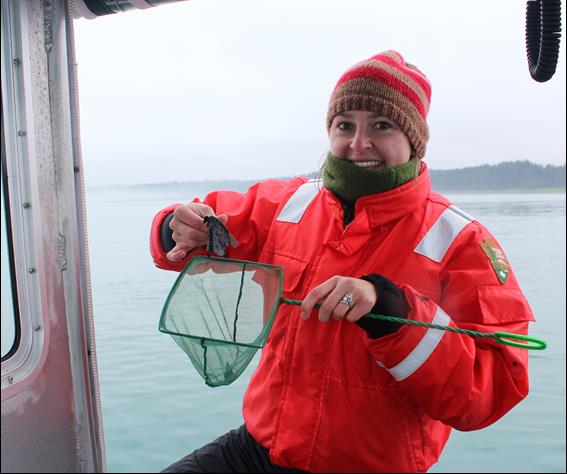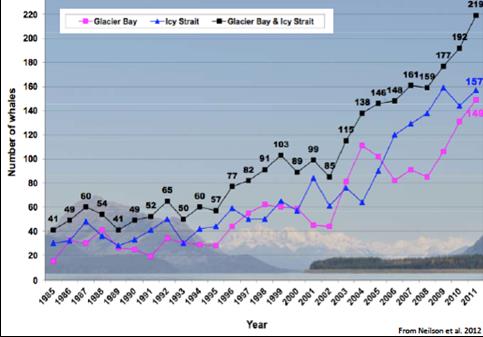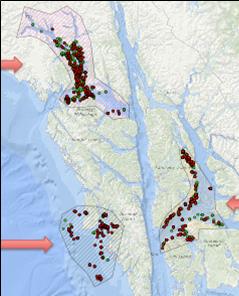How closely related are whales that summer in Glacier Bay? How related are they to whales elsewhere in Southeast Alaska?
Project Dates
2013 - 2014
Did You Know?
It is unusual for humpback whales to engage in coordinated feeding behavior. However, at two locations in Southeast Alaska, not only do whales form cooperative feeding groups, but the same individual whales have re-united every summer for decades. This behavior is not known to occur anywhere else in the world.
Introduction

Glacier Bay has an especially extensive history of humpback whale monitoring. A collaboration between the National Park Service and the University of Alaska Southeast has created a catalog containing 15,000 fluke (tail) identification photos of 1,900 individual whales taken since 1979. Skin tissue samples have been collected since 1987, and DNA profiles have been created for nearly 1,000 of these samples. Expanding and integrating these two extensive sets of records, graduate student Sophie Pierszalowski is exploring the relatedness and population structure of Southeast Alaska whales.
In 1985, 41 individual humpback whales were identified in Glacier Bay and Icy Strait during the summer feeding season. By 2011 this number had increased to 219. This study is investigating whether this increase is mostly due to reproduction of whales identified in 1985 or earlier, or whether immigration has been a factor.
The researcher also seeks to understand the social structure of group-feeding humpback whales at Point Adolphus, and whether these whales, which have been feeding together for decades, are related to one another.
Finally, this research asks whether humpback whales in the three distinct feeding regions in Southeast Alaska (Glacier Bay/Icy Strait, Sitka Sound, and Frederick Sound/Seymour Canal) are genetically differentiated. Fidelity to these sites is believed to be maternally directed: mothers take calves to specific feeding grounds, to which the offspring return every year. Some whales tend to stay in one of these areas for much of the summer, while others visit two or even all three areas in a given year. It is not known whether this combination of movement and site fidelity is reflected by discernible genetic differences in whales among the areas.
Methods and Findings
This study attempts to answer three main questions by integrating two well-established, long-term datasets of photo-ID records and DNA profiles.

Question 1. Are all of the growing number of Glacier Bay/Icy Strait whales descended from a “founder” population, or has immigration played a role in population increase?
A list of 78 “founder” whales was created based on photo ID records going back to 1973. DNA profiles are available for 47 of these whales. By matching photo-ID and DNA profiles, the researcher will determine how many of today’s whales are either members of the “founder” group or the offspring of founder members.
The research has so far determined that 37 out of 78 founder whales are still alive and return to Glacier Bay/Icy Strait every year.
Question 2. Are members of the Point Adolphus “core group” of whales genetically related to one another?
A core group of about nine whales that have been feeding together since the 1980s was identified. The researcher will compare the DNA of these whales with other Pt. Adolphus whales not in the core group to determine whether core group members are more closely related to one another than to non-core group whales.

Question 3. Are Glacier Bay/Icy Strait whales genetically distinct from whales in other parts of Southeast Alaska?
The DNA of whales in the three distinct feeding areas is analyzed and compared. Because site fidelity is believed to be maternally-directed, but females may mate with males from other regions on the common breeding ground of Hawaii, maternally-inherited DNA would be expected to show more structure than bi-parentally-inherited DNA in Southeast Alaska whales. By analyzing this and other genetic information the study advances understanding of the genetic differences and similarities of whales in the three zones.
Preliminary results indicate that Glacier Bay/Icy Strait whales are not genetically differentiated from whales in Sitka Sound or Frederick Sound/Seymour Canal.
Learn More
Glacier Bay whale research page: www.nps.gov/glba/naturescience/whales.htm
Cascadia Research website: www.cascadiaresearch.org/
Oregon State Cetacean Conservation Genetics Lab website: www.mmi.oregonstate.edu/ccgl
Last updated: September 15, 2016
